Systematic substitutions at BLIP position 50 result in changes in binding specificity for class A β-lactamases
- PMID: 28264645
- PMCID: PMC5340008
- DOI: 10.1186/s12858-017-0077-1
Systematic substitutions at BLIP position 50 result in changes in binding specificity for class A β-lactamases
Abstract
Background: The production of β-lactamases by bacteria is the most common mechanism of resistance to the widely prescribed β-lactam antibiotics. β-lactamase inhibitory protein (BLIP) competitively inhibits class A β-lactamases via two binding loops that occlude the active site. It has been shown that BLIP Tyr50 is a specificity determinant in that substitutions at this position result in large differential changes in the relative affinity of BLIP for class A β-lactamases.
Results: In this study, the effect of systematic substitutions at BLIP position 50 on binding to class A β-lactamases was examined to further explore the role of BLIP Tyr50 in modulating specificity. The results indicate the sequence requirements at position 50 are widely different depending on the target β-lactamase. Stringent sequence requirements were observed at Tyr50 for binding Bacillus anthracis Bla1 while moderate requirements for binding TEM-1 and relaxed requirements for binding KPC-2 β-lactamase were seen. These findings cannot be easily rationalized based on the β-lactamase residues in direct contact with BLIP Tyr50 since they are identical for Bla1 and KPC-2 suggesting that differences in the BLIP-β-lactamase interface outside the local environment of Tyr50 influence the effect of substitutions.
Conclusions: Results from this study and previous studies suggest that substitutions at BLIP Tyr50 may induce changes at the interface outside its local environment and point to the complexity of predicting the impact of substitutions at a protein-protein interaction interface.
Keywords: Beatmusic; Binding specificity; Systematic substitutions; β-lactamase.
Figures
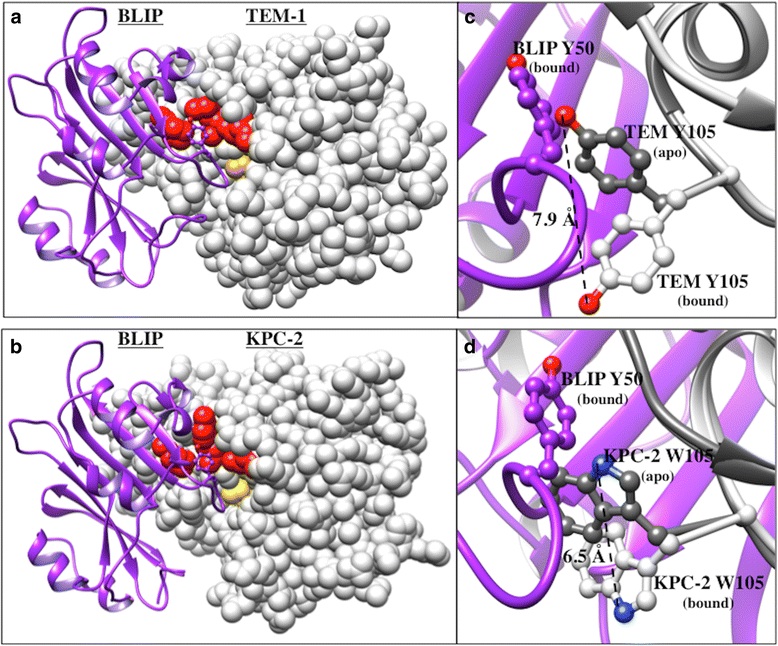
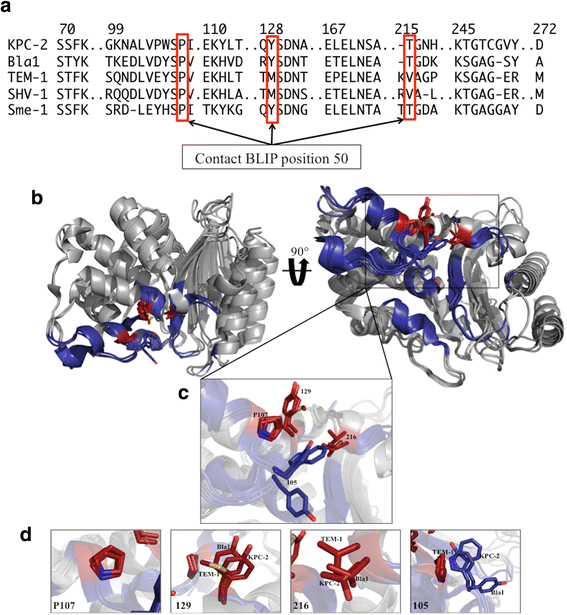
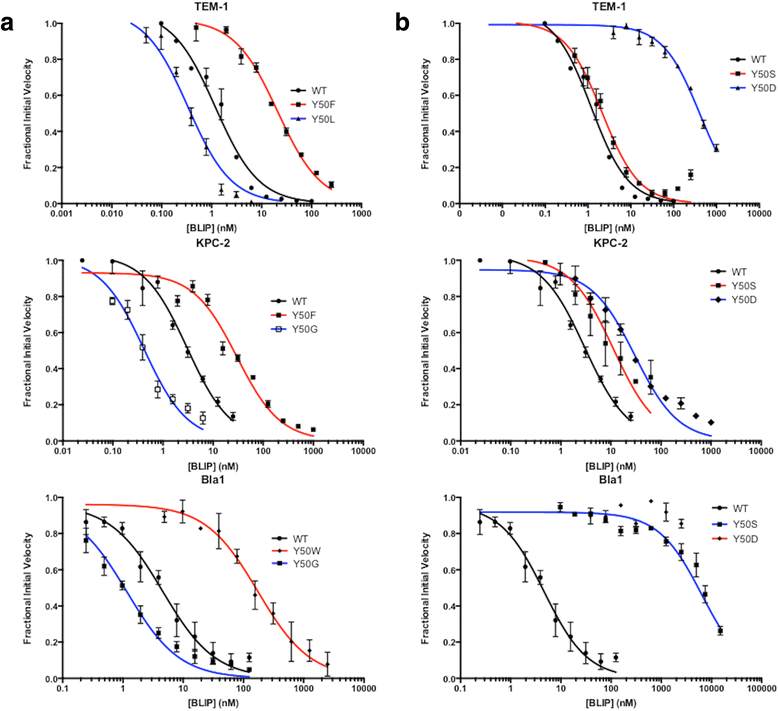
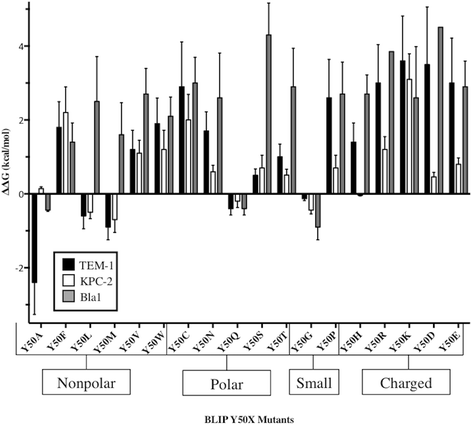
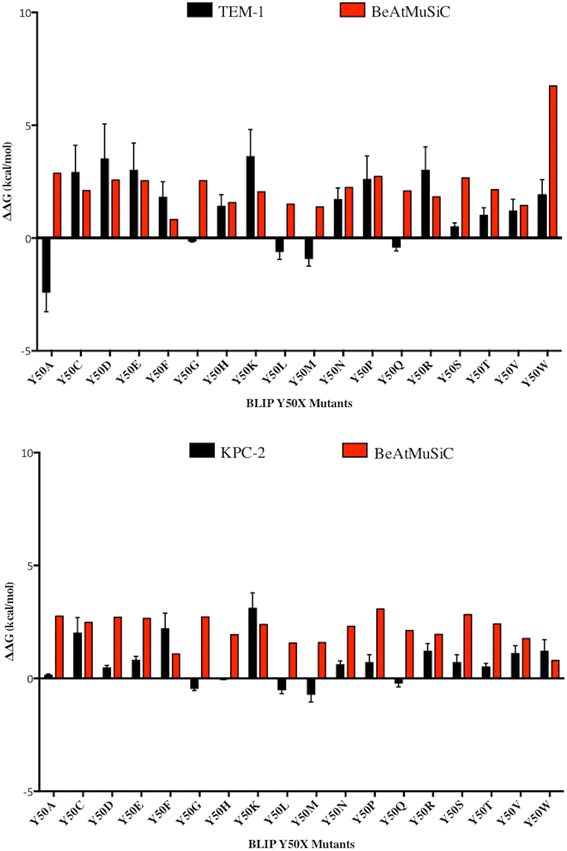
Similar articles
-
Dissecting the protein-protein interface between beta-lactamase inhibitory protein and class A beta-lactamases.J Biol Chem. 2004 Oct 8;279(41):42860-6. doi: 10.1074/jbc.M406157200. Epub 2004 Jul 28. J Biol Chem. 2004. PMID: 15284234
-
Engineering Specificity from Broad to Narrow: Design of a β-Lactamase Inhibitory Protein (BLIP) Variant That Exclusively Binds and Detects KPC β-Lactamase.ACS Infect Dis. 2016 Dec 9;2(12):969-979. doi: 10.1021/acsinfecdis.6b00160. Epub 2016 Oct 26. ACS Infect Dis. 2016. PMID: 27756125 Free PMC article.
-
Analysis of the binding forces driving the tight interactions between beta-lactamase inhibitory protein-II (BLIP-II) and class A beta-lactamases.J Biol Chem. 2011 Sep 16;286(37):32723-35. doi: 10.1074/jbc.M111.265058. Epub 2011 Jul 20. J Biol Chem. 2011. PMID: 21775426 Free PMC article.
-
Insight into Structure-Function Relationships of β-Lactamase and BLIPs Interface Plasticity using Protein-Protein Interactions.Curr Pharm Des. 2019;25(31):3378-3389. doi: 10.2174/1381612825666190911154650. Curr Pharm Des. 2019. PMID: 31544712 Review.
-
Protein-protein recognition.Prog Biophys Mol Biol. 1995;64(2-3):145-66. doi: 10.1016/s0079-6107(96)00001-6. Prog Biophys Mol Biol. 1995. PMID: 8987382 Review. No abstract available.
Cited by
-
Tackling the Antibiotic Resistance Caused by Class A β-Lactamases through the Use of β-Lactamase Inhibitory Protein.Int J Mol Sci. 2018 Jul 30;19(8):2222. doi: 10.3390/ijms19082222. Int J Mol Sci. 2018. PMID: 30061509 Free PMC article.
-
Exploring Additional Dimensions of Complexity in Inhibitor Design for Serine β-Lactamases: Mechanistic and Intra- and Inter-molecular Chemistry Approaches.Front Microbiol. 2018 Apr 5;9:622. doi: 10.3389/fmicb.2018.00622. eCollection 2018. Front Microbiol. 2018. PMID: 29675000 Free PMC article. Review.
-
Rheostat positions: A new classification of protein positions relevant to pharmacogenomics.Med Chem Res. 2020 Jul;29(7):1133-1146. doi: 10.1007/s00044-020-02582-9. Epub 2020 Jun 7. Med Chem Res. 2020. PMID: 32641900 Free PMC article.
-
Structural Plasticity Is a Feature of Rheostat Positions in the Human Na+/Taurocholate Cotransporting Polypeptide (NTCP).Int J Mol Sci. 2022 Mar 16;23(6):3211. doi: 10.3390/ijms23063211. Int J Mol Sci. 2022. PMID: 35328632 Free PMC article.
References
-
- Kuzu G, Keskin O, Gursoy A, Nussinov R. Constructing structural networks of signaling pathways on the proteome scale. Curr Opin Struc Biol. sciencedirect; 2012;22:367–377 - PubMed
-
- Jubb H, Higueruelo A, Winter A, Blundell T. Structural biology and drug discovery for protein–protein interactions. Trends Pharmacol Sci. 2012;33:241–248. - PubMed
-
- Selzer T, Albeck S, Schreiber G. Rational design of faster associating and tighter binding protein complexes. Nat. Struct. Biol. 2000;7:537–41. - PubMed
Publication types
MeSH terms
Substances
Grants and funding
LinkOut - more resources
Full Text Sources
Other Literature Sources
Miscellaneous

